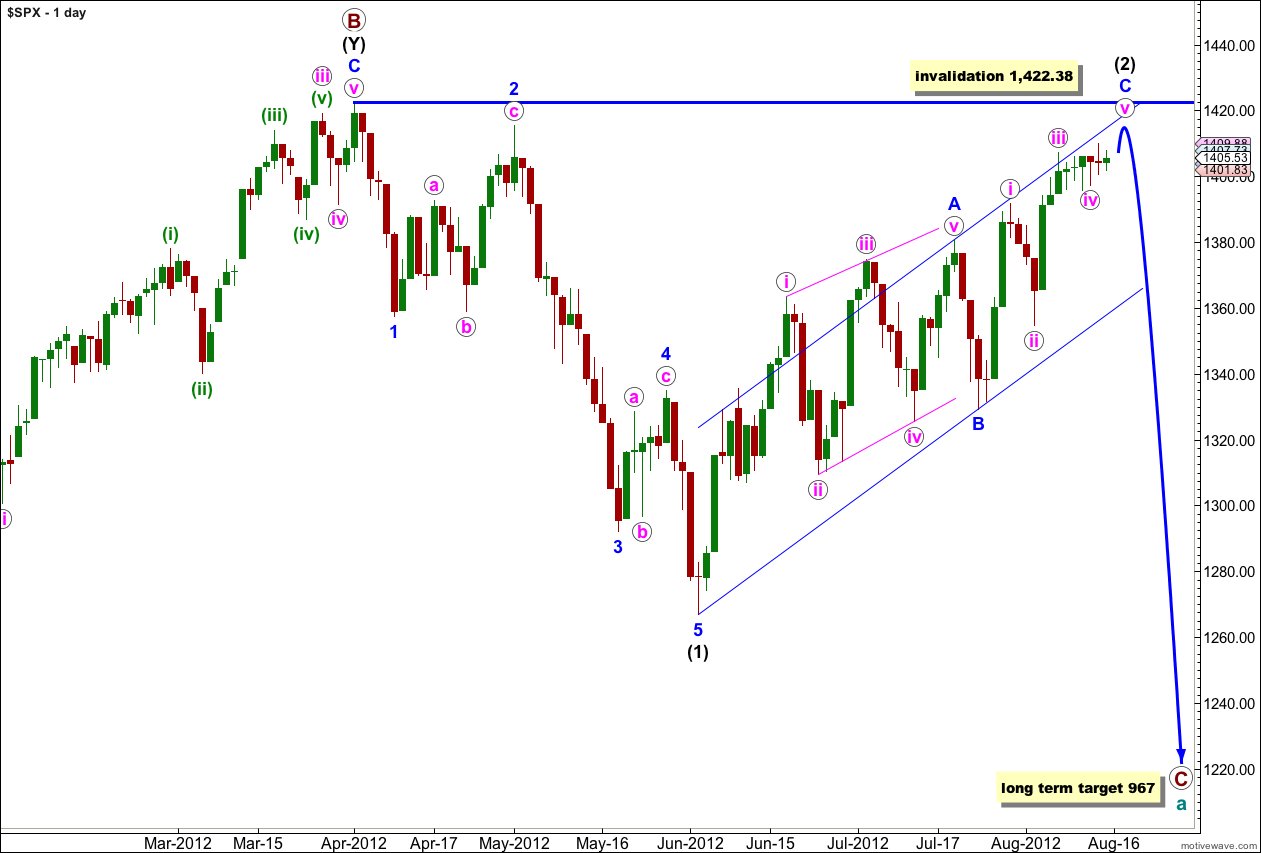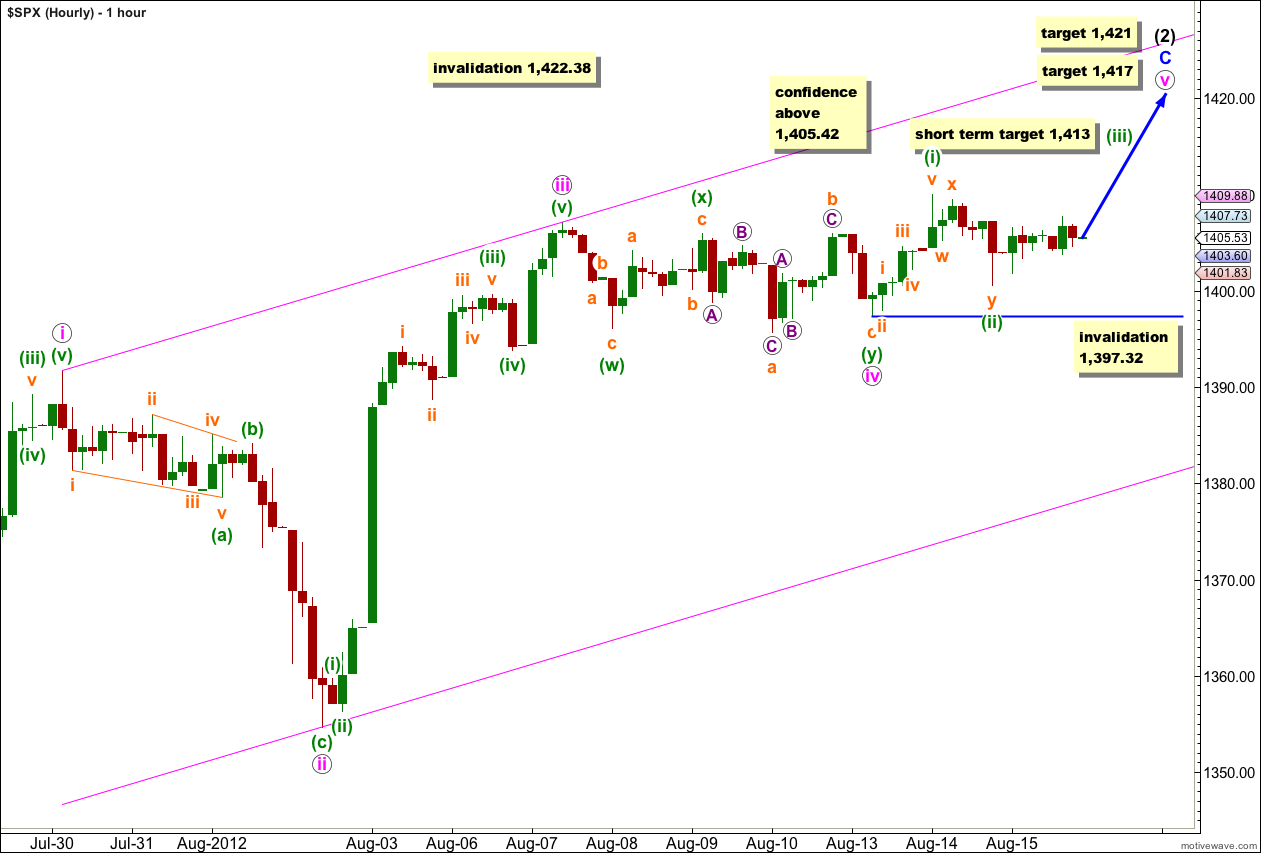With the S&P 500 again moving very slowly sideways within a small range both of yesterday’s hourly wave counts remain valid. Looking at the subdivisions of Wednesday’s movement on the 5 minute chart may give some clues as to which wave count has a higher probability.
I still have only one daily wave count.
Click on the charts below to enlarge.
If wave (2) black is a single zigzag then wave A blue was a leading diagonal and it would be likely that wave C blue would be an impulse to see alternation between the two.
We may use Elliott’s channeling technique to draw a parallel channel about wave (2) black. When this channel is breached by downwards movement we should have confirmation of a trend change. Prior to confirmation of a trend change we must accept the possibility of new highs.
When wave C blue is confirmed as complete then the only way that wave (2) black could continue further would be as a very rare triple zigzag. The rarity of triples means the probability of wave (2) black continuing further is extremely low. Also, for the S&P 500 to continue further within this correction it would diverge significantly with the Dow. For the Dow the only corrective structure which fits the upwards movement and meets all rules is a triple zigzag, so when this last movement is over the correction cannot continue further.
Wave (2) black may not move beyond the start of wave (1) black. This wave count is invalidated with movement above 1,422.38.
If this wave count is invalidated with movement above 1,422.38 then the only explanation that I can see at this point is the first alternate monthly wave count in the historic analysis here.
Main Hourly Wave Count.
Sideways movement during Wednesday’s session subdivides nicely on the 5 minute chart to five wave structures upwards and three wave corrective structures downwards. This slightly increases the probability of this wave count.
However, I would have expected the start of a third wave, even one at minuette (green) degree, to exhibit stronger momentum. This slightly reduces the probability of this main wave count.
I have considered the possibility that sideways movement may still be a continuation of wave iv pink as a very rare triple combination. This is possible, and the structure would be incomplete. If we see another two to three days of sideways movement and if price does not move below 1,391.74 then this may be an explanation. For this reason I am adding a confidence point at 1,391.74 to the alternate which looks at the possibility of a trend change.
For this main wave count the situation is little changed from last analysis. At 1,413 wave (iii) green would reach equality with wave (i) green. Thereafter, a very shallow fourth wave correction may not move back into wave (i) green price territory.
At 1,417 wave v pink would reach 0.382 the length of wave iii pink. If price continues to rise through this first target then the next likely target is at 1,421 where wave v pink would reach 0.382 the length of wave i pink.
Movement above 1,410.03 would invalidate the alternate below and provide confidence for this main hourly wave count.
Wave (2) black may not move beyond the start of wave (1) black. This wave count is invalidated with movement above 1,422.38.
Alternate Hourly Wave Count.
Sideways movement for a possible wave iv orange zigzag does not fit well on the 5 minute chart; wave C within it does not subdivide into a five. It could be that wave iv orange is incomplete, but this would look a little strange as it would be out of proportion to waves i, ii and iii orange..
If price moves below 1,397.32 this alternate wave count would have initial confirmation.
Movement below 1,391.74 would eliminate the possibility that wave iv pink is not over (a rare triple combination) and so would provide some confidence in this wave count.
Movement below the parallel channel on the hourly chart would provide trend channel confirmation of a trend change.
Within wave (3) black downwards no second wave correction may move beyond the start of its first wave. This wave count is invalidated with movement above 1,410.03.



